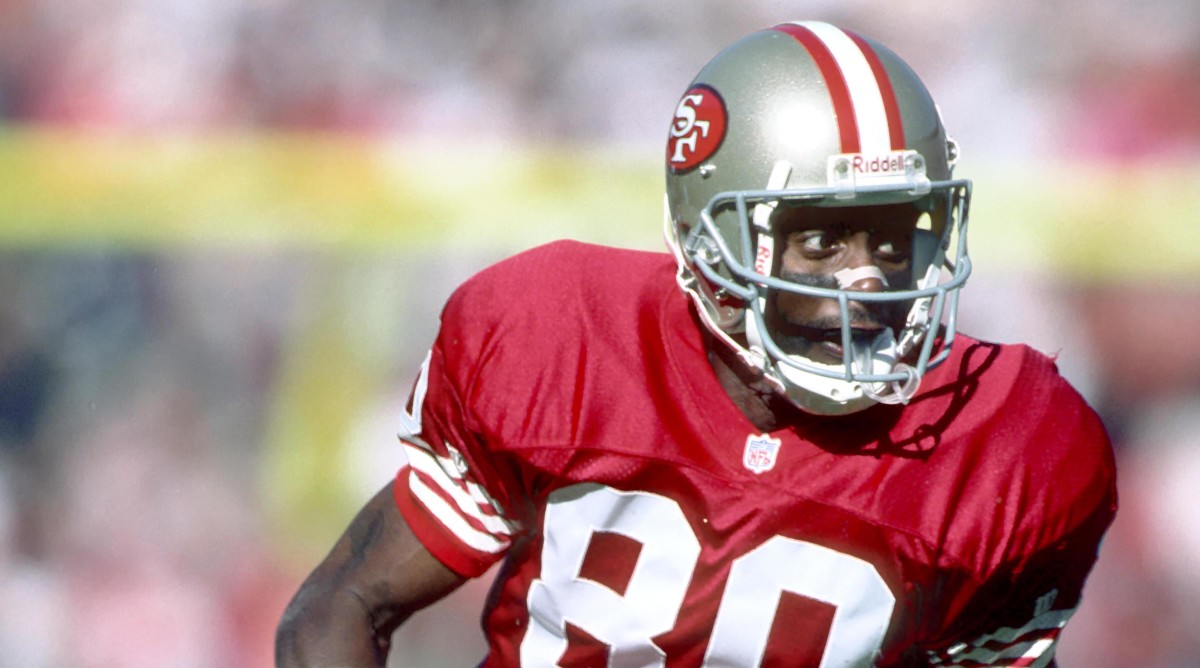Fantasy Football 2023: Rise of the Receivers
Running backs have long been the lifeblood of fantasy football. In the early days of our great hobby, passing on a featured back also meant you were likely passing on a postseason berth. This isn’t hyperbole, either, as the numbers back up the words.
Historical data will show the importance placed on drafting the best running backs early and often. But as we move from the 1980s up until recent years, we can see the trend shifting.
In the decade of the 1980s, the top six non-quarterback fantasy point producers in standard scoring leagues (PPR hadn’t yet come into prominence) were all running backs. That list included Eric Dickerson, Walter Payton, Marcus Allen, Tony Dorsett, Roger Craig and O.J. Anderson. There were three wideouts – Steve Largent, James Lofton and Art Monk – but 70% of the “elite” players came from NFL backfields.

If we go even deeper, we’ll find that 64% of the players in the top 36 (factoring in flex players in a 12-team league) in the decade were also runners. Wideouts made up a mere 33% of the top 36 players. To further bring home the point that runners were the dominant force, we also find that eight of the 10 best single seasons in the ‘80s belonged to backs. Just one wide receiver – not surprisingly, the great Jerry Rice – broke into the top 10. He did it twice, first in 1986 and again in 1989.
Furthermore, 78% of the top 36 fantasy single seasons in the decade came from backs. A mere 22% were from wideouts, and three of them came from Rice.
The 1980s came and went, but things didn’t change in the 1990s. In fact, running backs became even more dominant in many respects. While the top 10 players of the entire decade included fewer backs (six compared to seven in the 1980s), the single-season totals were full of some of the greatest runners in fantasy history.
Believe it or not, just one of the top 20 single seasons based on standard scoring came from a wide receiver (Rice again, 1995). The other 19 were all runners, including the likes of Terrell Davis, Emmitt Smith, Barry Sanders, Marshall Faulk, Edgerrin James, Thurman Thomas, Fred Taylor and Curtis Martin. If we look at the top 36, just 14% of the best single seasons came from receivers (three of them came from Rice).
You might call the 1990s the Golden Age of the Running Backs, as the position was maybe more talented than ever before during the dawn of fantasy football. It was also in the late ‘90s when we started to see an increase in the popularity of fantasy sports paralleled with the start of the world wide web, better known as the internet.
With fantasy sports starting to boom and running backs thriving at that same time, it’s only natural that the position was considered vital to success. When we hit the 2000s, backs remained a must-have in the early rounds. The fantasy torch had been passed on from Marshall Faulk to the likes of Edgerrin James and LaDainian Tomlinson, but the position remained dominant, nonetheless. Six of the top 10 best players of the decade were again runners, but single-season supremacy increased.
In fact, the top 21 fantasy seasons of the 2000s came from running backs. Think about that! Not a single wideout was in the top 21. The best campaign from a wide receiver came from Randy Moss in 2007, but the next 13 best fantasy seasons were accomplished by runners. In fact, Moss is the lone wideout to finish in the 36 among non-quarterbacks in the decade. Even if we move on to PPR formats, just 25% of the top 36 single seasons came from wide receivers. Besides Moss, the only other wideouts included superstars the likes of Marvin Harrison, Torry Holt, Steve Smith Sr., Hines Ward, Terrell Owens and Muhsin Muhammad.
PPR Format Gains Acceptance
Moving on to the 2010s, more and more fantasy fans were going away from the standard scoring formats and into leagues that also rewarded points for catches. That alone was going to help ignite a surge of wide receivers. While backs still did well in standard leagues, their dominance was no longer as pronounced.

Six of the top 10 players of the decade were still backs, but two of the top three were receivers (Antonio Brown, Julio Jones) in non-PPR formats. Runners also saw a decline in their mastery of fantasy football over the course of the decade, making up 42% of the 36 best single seasons in standard leagues. That’s the lowest we have seen in this research. On the flip side, wideouts made up for 50% of the top 36.
That percentage rises to 64% in PPR formats, with just nine runners (25%) making the list. Also, four of the top five players were wideouts in PPR formats. That list includes Brown, Jones, Larry Fitzgerald and Demaryius Thomas. The lone back in the top five, LeSean McCoy, was a successful pass catcher and thus had added value in PPR formats. The same goes for Matt Forte, a star fantasy running back who ranks sixth in the decade. They were the lone two runners who finished in the top 12.
Unsurprisingly, we also had new rules across the league during this time that better protected quarterbacks, made it tougher for defensive backs to defend and thus created a spike in wide receiver production. Those rules, unfortunately for running backs, didn’t benefit that position. What’s more, we’ve also started to see an increase in the number of backfield committees, which further hurt the value of the position.
Now, let’s move on to the last three seasons, where we really start to see the power of PPR scoring, and how it’s affected how we’ll draft our fantasy football teams.
While running backs have remained valuable in standard scoring, holding seven of the top 10 places based on combined points since 2020, wideouts still hold 15 of the top 36 spots. That’s just four fewer spots than runners (19). Remember, the gap was much wider when we looked at the two positions during the earlier decades.
In PPR formats we’ve seen a similar story, but the gap is bigger. In fact, the top four players since 2020 are all wideouts. That list includes studs Davante Adams, Justin Jefferson, Tyreek Hill and Stefon Diggs. While we’re still seeing plenty of backs with strong numbers (four in the top 10 and six in the top 12), wideouts now have the lead in top-20 players since 2020 (55%). By comparison, the backs make up 35%.
Most Fantasy Points (PPR) Since 2020:
Player | Position | Points |
|---|---|---|
Davante Adams | WR | 1038.2 |
Justin Jefferson | WR | 973.1 |
Tyreek Hill | WR | 972.6 |
Stefon Diggs | WR | 930.7 |
TE | 891.9 | |
Austin Ekeler | RB | 881.8 |
Cooper Kupp | WR | 849.6 |
RB | 829.2 | |
Alvin Kamara | RB | 824.2 |
Josh Jacobs | RB | 785.6 |
Besides rules changes and the NFL becoming more of a passing league, we’re also seeing more rookie wide receivers coming in and making an immediate impact. That wasn’t always the case, as fantasy fans would often wait two or three years for a receiver to make some noise. The trend includes some of the best players of all time at the position. Terrell Owens didn’t have his first 1,000-yard season until his third year. Marvin Harrison’s first monster fantasy campaign came in his fourth season, and Calvin Johnson had a modest 756 yards and four touchdowns as a rookie.
Nowadays, that hasn’t been the case. In fact, the opposite has been true,
A number of rookie receivers have come right into the league and made their mark, which increases the number of great fantasy players at the position. Let’s start off with Justin Jefferson, who scored 1,400 yards, seven touchdowns and 274.2 points in his first season with the Vikings. He finished sixth in points, and he’s been even better over the last two years. In fact, Jefferson’s reception, yardage and fantasy point totals have all increased in his first three seasons in the league.
Next up is another LSU wide receiver, Ja’Marr Chase.
He recorded 304.6 fantasy points in his first year. That’s the second-most all-time PPR points scored among rookie wideouts behind Randy Moss (306.7). His 1,455 receiving yards set a rookie record, and only Moss (18) had more touchdowns (13). Chase followed up that season with 1,046 yards and nine touchdowns (12 games), and he averaged more points (20.2) compared to his first campaign (17.6).
Jefferson and Chase aren’t the lone youngsters to come in and light the fantasy world on fire, either. Jaylen Waddle caught 104 passes and had over 1,000 yards in his rookie season. Amon-Ra St. Brown had 90 catches for 912 yards, and CeeDee Lamb had 74 catches and 935 yards. Last season, we saw Garrett Wilson win the Offensive Rookie of the Year award with his 83 catches and 1,103 yards. Chris Olave and Drake London also both scored more than 178 fantasy points in 2023.
In all, seven of the top 10 non-quarterback rookies have been wide receivers since 2020. Furthermore, 11 of the top 20 rookies and 19 of the top 36 are wideouts, too. On the flip side, three running backs are in the top 10, seven are in the top 20 and 15 of the top 36 are runners. As you can see, the receivers are winning the battle.
This influx of talented, young wide receivers has obviously been a big reason, and it’s created a bigger discrepancy in PPR point totals between the two positions.
The top five wideouts in the last three seasons have averaged 20.2 points per game, which is more than a full point more than runners (18.9). If we look at the top 36, we find that wide receivers have averaged a full point more than running backs overall.

Individually, six receivers averaged more than 18 points per game compared to four backs in the top 36. We’ve also seen 16 receivers average 15-plus points compared to 12 backs in that same research. No matter how you cut it, wideouts are ruling the fantasy roost. That influx of young talent has made receivers a younger position, too.
In 2022, six of the top 10 fantasy wideouts were 25 or younger and only Adams (30) finished the season older than 29. Thirteen of the top 20 were under 27, and none were older than 29. If we extend out to the top 36, we find 24 receivers who were 26 or younger at the end of the season. Overall, the average age of the top 10 players at the position was 25.7 and the average of the top 36 was 24.9.
The running backs aren’t ancient by any stretch, but they’re a bit older.
The top 10 included just four players under 26, and the average age was 26. When we look at the top 36, the average age is 25.7 years old, nearly a year older than the wideouts. Running backs are also seeing the decline of several one-time superstars.
Dalvin Cook averaged a career-low 4.4 yards per rush last season and is entering his age 28 campaign. Alvin Kamara’s stock has fallen over the last two years without Drew Brees and he’s entering his age-28 season, too. Aaron Jones will be 29 at the end of the year, Cordarrelle Patterson is 32 and former superstars Ezekiel Elliott and Leonard Fournette are aging and have seen their skills (and production) decline.
Fantasy managers also must wonder when the floor will drop out on Derrick Henry, who is entering his age-29 season and has seen a ton of carries (1,249 in his last 55 regular-season games, to be exact). Several others, including Joe Mixon, Najee Harris and D’Andre Swift, experienced declines compared to their 2022 totals.
A number of these runners are also going to find themselves in committees, which will make starting them in fantasy leagues frustrating at times. Jones will lose work to AJ Dillon in Green Bay, the Saints added Jamaal Williams to pair with Kamara, Swift will lose valuable opportunities to David Montgomery, and Pierce will have to deal with Devin Singletary in Houston. That’s just a few of the shared backfields.
With all this data and the trends that have developed, it’s clear that wide receivers have moved into that rarified fantasy air and are on the same level as the backs. In fact, wideouts have passed the runners in many respects. That includes the No. 1 overall pick, which is no longer a running back. This scenario has been an unusual one, too, as just one non-back has been the consensus top fantasy pick since 2014.
That player was Antonio Brown, who was the first of three wideouts (Julio Jones, Odell Beckham Jr.) in the top five based on average draft position data. David Johnson and Todd Gurley were the top backs, going third and fifth on average.
Brown will now have some company, though, as Jefferson has moved into the consensus top spot as the No. 1 overall fantasy selection in 2023. Early ADP data has him going ahead of Christian McCaffrey and Chase, and that’s unlikely to change based on trends of the last few decades (and in the last three seasons).
Jefferson is certainly worthy, scoring the second-most PPR points behind Adams among non-quarterbacks since 2020. He has the third-most targets, the third-most catches and the most receiving yards, and he’s still just a kid entering his age-24 season. Simply put, Jefferson and other wideouts like Chase, Cooper Kupp and CeeDee Lamb (to name a few) are just safer draft picks among the top 12-15.
Those are hard words for me to say, because no one has been more or a running backs truther than me over the last two-plus decades. But like Yoda once said in The Empire Strikes Back, “you must unlearn what you have learned.” In this case, that means coming to your draft knowing wide receivers are going to come off the board faster than ever before and knowing you can now wait on a running back.
That doesn’t mean you’ll still be able to draft an elite back like McCaffrey, Austin Ekeler, Saquon Barkley or Jonathan Taylor, because you won’t. What it does mean is that there will be better runners available in the third round and beyond, as the wideouts become the early-round focus. It might sound strange, but it’s true.
The reality in our fantasy lives is that Jefferson, Chase, Kupp, Adams, Diggs, Lamb and other receivers are going to be picked more prominently than ever before, and you have to be fine with doing something that hasn’t been done often in recent years … waiting a round or two (or maybe longer) to draft your running backs.
